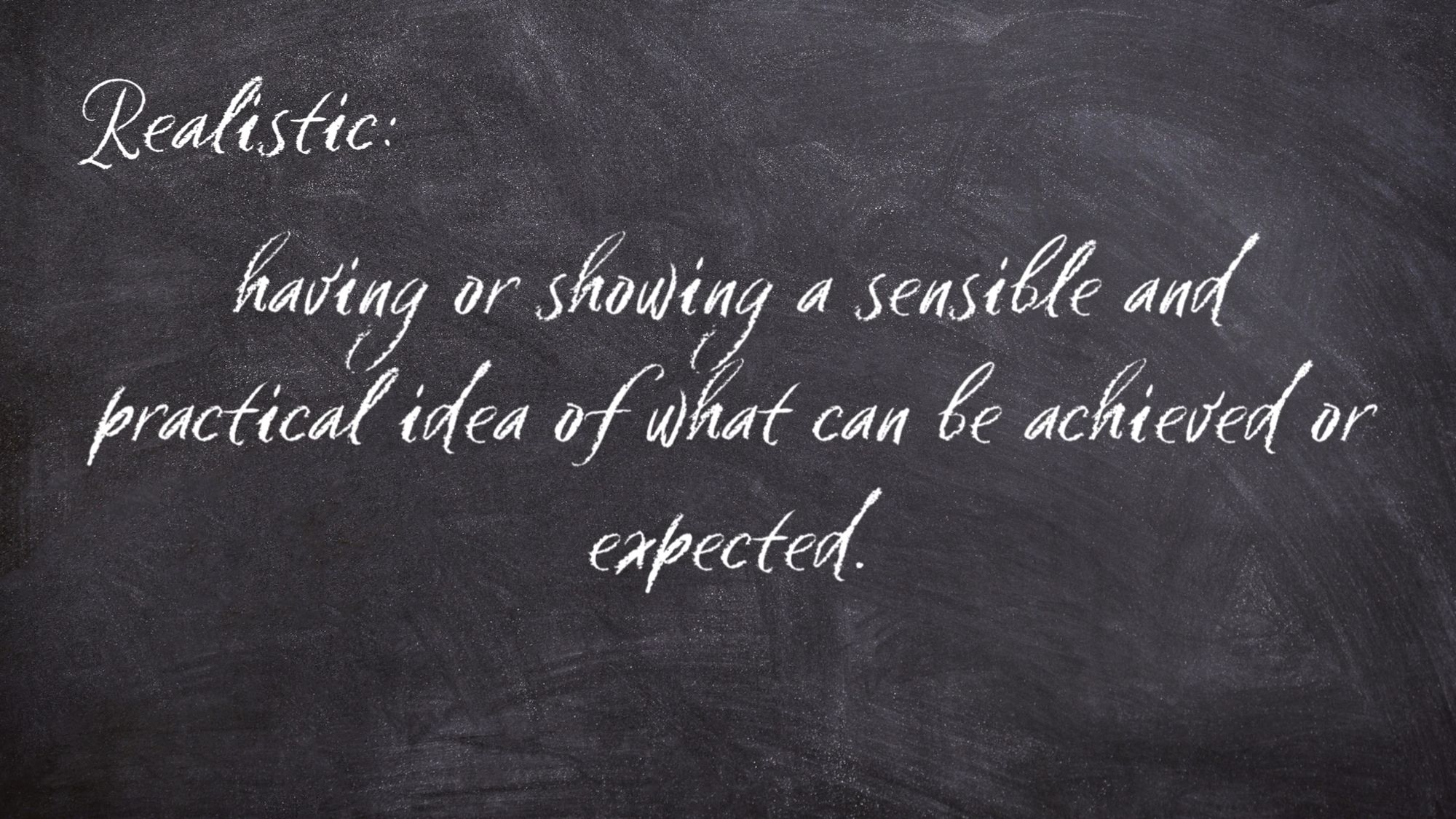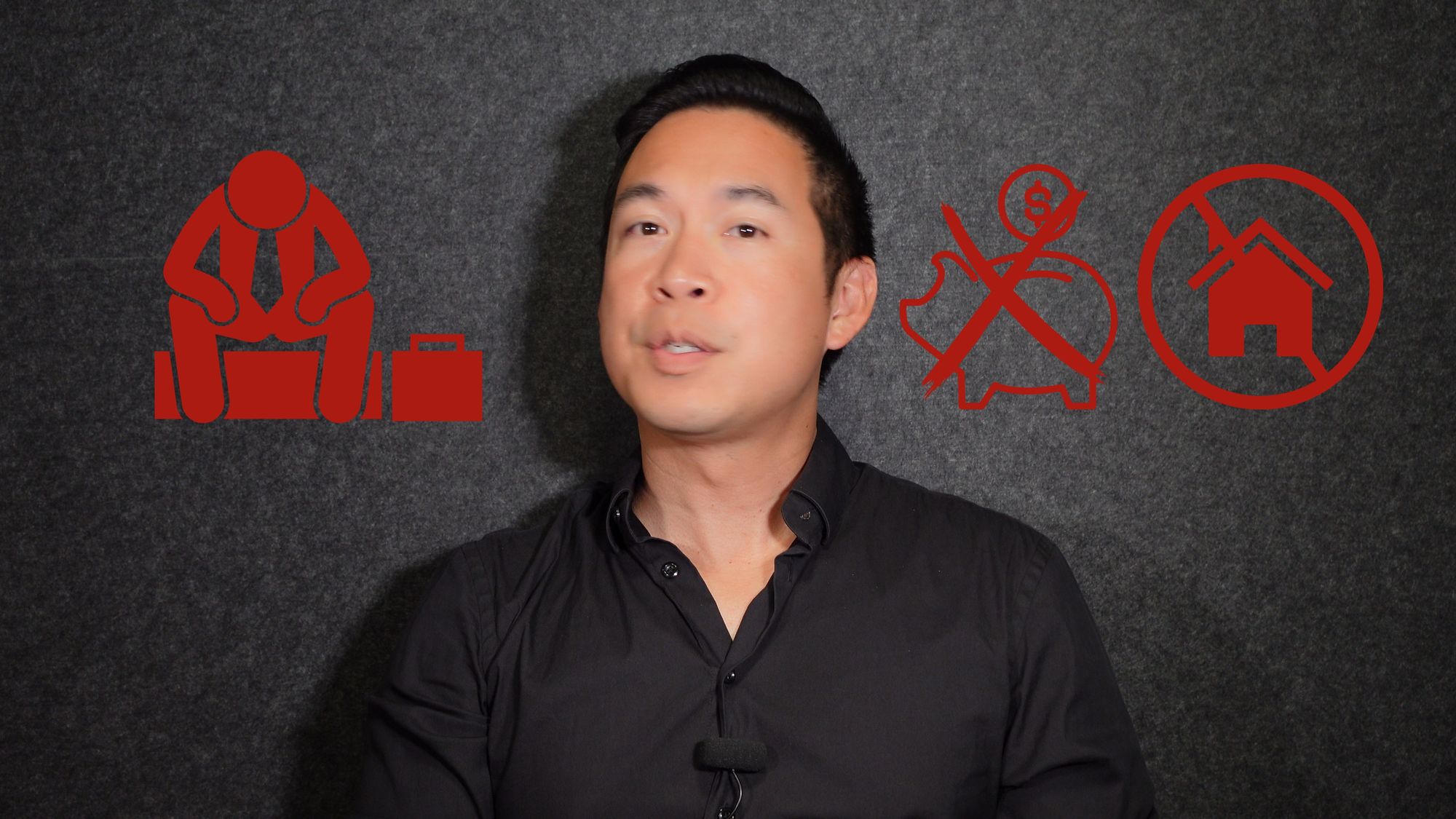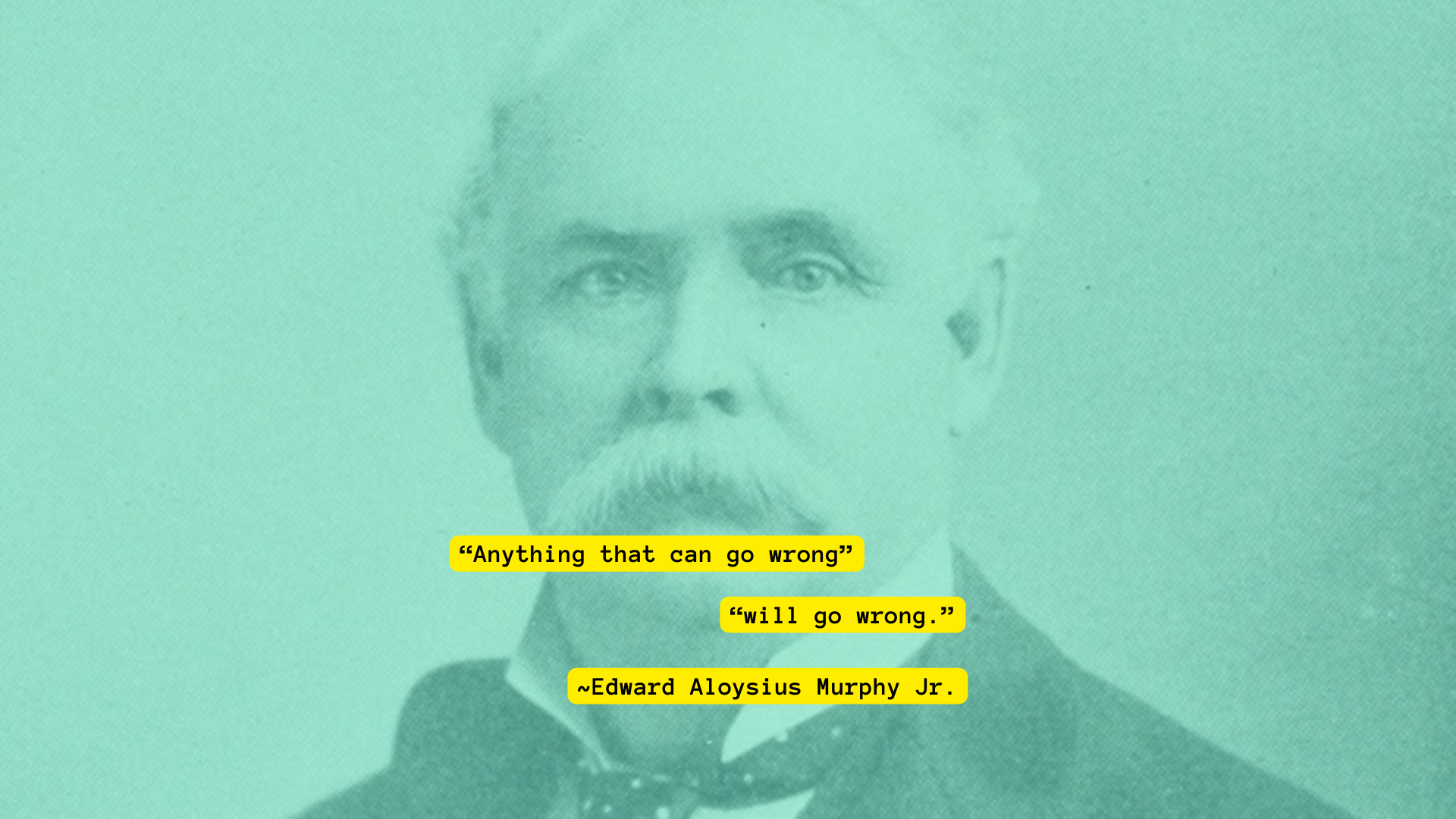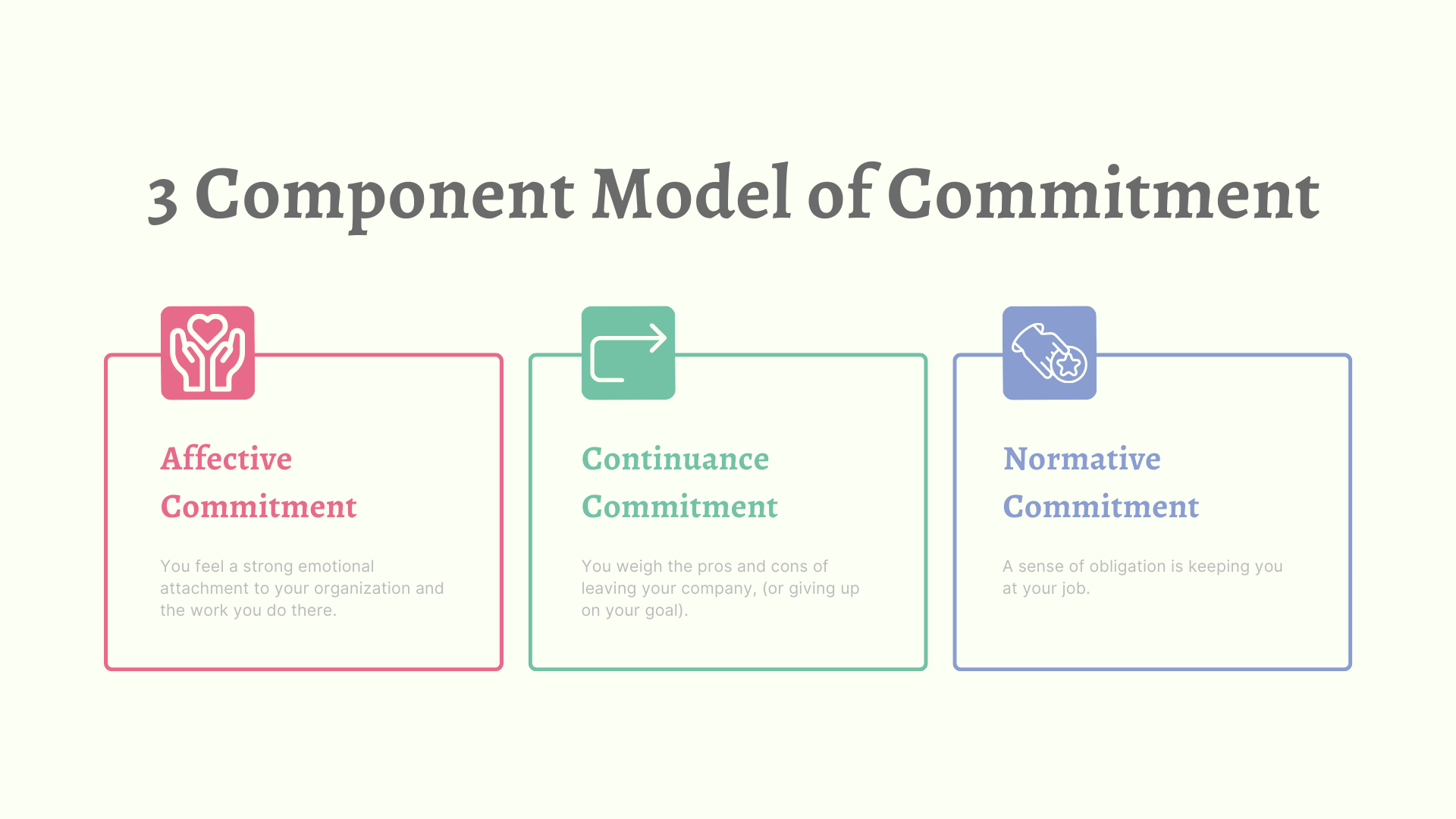Realistic

Goals have been a part of our lives since we were little babies. Our pediatricians would provide us with growth and behavioral milestones to track our development. Elementary schools would give us guidelines as to what abilities or skills we should have at different grade levels. In High schools and universities, how well goals were met were measured with grades which would determine whether we could advance to higher levels.
Although many of our early goals revolved around education, all areas of our lives have goals to achieve. It could be health, career, hobbies, finances, or even personal development. Having goals is an important part of successful achievement. There is no doubt about that. A particular aspect of creating goals that are often overlooked is to keep them realistic. Being realistic with the goals that you set for yourself will set the stage for the greatest chances of success.
DEFINITION OF REALISTIC

What exactly does keeping your goals realistic mean? The dictionary defines realistic as “having or showing a sensible and practical idea of what can be achieved or expected”. For example, if you’ve never exercised before and then you say, tomorrow, I’m going to do 100000 sit-ups. This is simply not realistic. It would be more realistic to say, after acknowledging that you’ve never exercised before, you’re going to do three sets of 5 repetitions of getting up from sitting in a chair.
Being realistic means that you acknowledge your current state, you’re aware of the resources in your environment available to you, and you acknowledge your own skill sets and capabilities. If there’s an opportunity to translate Japanese to English for a program from Japan, and you don’t speak any Japanese, then it would be unrealistic to say that you could be successful at this opportunity.

Another example might be purchasing a million-dollar home. What would be your plan for that? If you don’t have a job, no savings, and no experience in real estate, and you say, “it’s easy, just make a million dollars first then buy the house”, this is not realistic. It would be more realistic to say you’re going to get your real estate license, learn the market by representing clients in buying or selling houses under the mentorship of a real estate broker, and then save your commissions to put a down payment on a home with a mortgage you could afford monthly payments on.
No one is telling you to not have lofty and ambitious goals. As a matter of fact, it’s great to have lofty and ambitious goals. Just set yourself up for success by setting realistic goals for yourself to achieve until you’ve created an environment in which your ability and resources available to you make your lofty goals a true possibility.
WRITING DOWN YOUR GOALS

One of the most deliberate acts to achieve something is writing down your goal. Writing your goals on paper is the first step in transforming them from a thought into something tangible. You’re manifesting it into reality. A Dominican University of California study conducted by Gail Matthews, which we’ll post a link to below, demonstrated that people who have written down their goals accomplish significantly more than those who don’t.
New Year’s Resolutions are a perfect example. Have you ever been so excited about the new year coming around so that you can have a fresh start to make some positive changes in your life? We’ve all been there, saying to ourselves, “I’m going to get into the best shape of my life this year!” Or “I’m going to stop eating fast food cold turkey.” Yes, the prospect of “being in the best shape of your life” or “stop eating fast food” sounds exciting but without writing it down and without a plan you’re bound to fail very quickly.

As a matter of fact, only 46% of people who actually set a resolution and write it down, are still successful after 6 months. Merely 4% of people who had similar goals but didn’t set resolutions were successful after 6 months.
If you really want to accomplish something, make sure to take that crucial first step. Write down your goal. Not only does the physical act of putting pen to paper and sticking it somewhere where you can see it everyday make it real. It also allows you to be reminded of it consistently, and it makes your goal a relevant part of each day. In every single person’s life, there are simply too many responsibilities and distractions to keep something as meaningful and significant as a personal goal, lost in a mental pile in your head.
NOT OPERATING IN A BUBBLE

I’m not exaggerating when I say mental pile. Did you know that the average person has around 6000 unique thoughts per day? With so much going on in your head, and knowing that the brain can only focus on one thing at a time, making time and having concrete action steps scheduled becomes even more crucial for the successful achievement of your goals.
As much as you might like to think so, you’re not operating in a bubble. You’re not separate from the environment you're in and trying to act upon. However, many people make goals without taking certain factors into account and they unknowingly set themselves up for failure before even taking action.
In a perfect world, our own effort and grit would be all we’d need to achieve our goals. For certain things where achieving a goal solely involves our own efforts, the work that needs to be done is straightforward. Learning a new skill, getting back into shape, being a better spouse or parent, mostly involves us practicing and developing new behaviors. Unfortunately, for goals that require the interaction or participation of others to become successful, other factors have to be taken into account.
-5.jpg?crop=entropy&cs=tinysrgb&fit=max&fm=jpg&ixid=MnwxMTc3M3wwfDF8c2VhcmNofDEzfHxzdGFydCUyMGElMjBidXNpbmVzc3xlbnwwfHx8fDE2NTM4MDgxOTQ&ixlib=rb-1.2.1&q=80&w=2000)
For example, if you were looking to start a business, do you have the money and time to commit to getting started and getting it off the ground? Do you have the right knowledge set to accomplish what you need to do? Is your geographic location suitable for what you want to achieve? Is what you want to do legal?
Let’s say you were in a particular state that has not allowed legal recreational use of marijuana but you hear about how lucrative this business could be. If your goal is to start a marijuana growing business, trying to establish it in your home state wouldn’t be realistic because of legal barriers.
But then you decide to relocate to Colorado where recreational marijuana use and starting a grow business is legal. Now the question is, do you have the knowledge to set up a grow operation? If not, who will you partner with to help you obtain and nourish your strains? Who will be your clients and do you have the avenues of transportation to transport your harvest to where they need to go?

You would also need to think about potential outside threats to you accomplishing your goal. How are your competitors? Do you have enough of a differentiation to bring value to your clients in a way that your competitors can’t?
As you can see, depending on what your goal is, you would have to have an honest assessment of your environment and what factors you’re dealing with so that you can successfully achieve your goal. There are a lot of things to consider.
REALISTIC IS NOT ANALYSIS PARALYSIS

What is important to remember is your intention and objective. All of this planning and consideration is for the purpose of taking action! I’ll say it again, all of this planning and consideration sets you up for success by setting realistic goals. In our video on Being Action Oriented, we discussed one of the main indicators that result inaction is Analysis Paralysis.
There is a crucial difference in considering factors to set realistic goals and analysis paralysis. In considering factors to set realistic goals, the intention and eventual outcome is to take action and move forward. In analysis paralysis, considering all these factors forms the basis for not taking action.
These two processes are approaching the same set of facts and factors with two different contexts. In goal setting, the context is being solution oriented and having a realistic view of what it will take to accomplish a goal. Subsequently, appropriate actions can be taken. In analysis paralysis, the context is being a deer in headlights, overwhelmed by all the considerations and staying stuck, paralyzed by all the things to consider. In one, your focus is on success through considerate action while in the other, your focus is on feeling overwhelmed and failure by default from inaction.
Examining these two contexts leads us to the most important factor in determining the outcomes of setting realistic goals. This most important factor is of course, you.
PLANNING FALLACY PHENOMENON

You could have the right context and intention to take action towards accomplishing your goals. You may have an accurate assessment of the environment, people, culture, and every other factor that is worth considering and you’ve set realistic goals based on your assessment. You’ve looked at everything outside but have you looked inside and made an honest assessment of your own abilities.
There is a phenomenon called the planning fallacy phenomenon. First proposed in 1979 by Daniel Kahneman and Amos Tversky, the planning fallacy phenomenon is “the tendency to underestimate the amount of time needed to complete a future task, due in part to the reliance on overly optimistic performance scenarios.”

In other words, you think that you’re more accurate, skilled, and capable than you truly are and you assume everything will go as planned without a hitch. You already know, based on prior experience, nothing ever goes perfectly the way you planned. As Captain Edward Aloysius Murphy Jr, the American aerospace engineer responsible for the eponymous Law stated, “anything that can go wrong will go wrong”.
To address any setback you might experience from the planning fallacy phenomenon, set realistic deadlines for yourself and add a 25% to your estimated time. Know your overall goal and prioritize the smaller goals along the way to maximize your efficiency. If at all possible, use history as a guide to help you anticipate what obstacles you might encounter, either from what you’ve experienced or what competitors or people after the same goal may have experienced.
Being realistic with your skills and potential setbacks you may face during the process of achieving your goals is one of the biggest ways to set yourself up for success. Ultimately, there is one aspect about yourself you must be brutally honest with to have truly realistic goals.
HONEST LEVEL OF COMMITMENT

This specific aspect I’m referring to is your level of commitment. During the many obstacles, trials, and tribulations you’ll encounter on the road to success is how important it is for you to stick it out and push through in spite of all the difficulties.
In 1991, John Meyer and Natalie Allen introduced the Three Component Model of Commitment. Although they introduced this model in the context of employees committing to their organization, I believe the principles they introduced do apply to understanding yourself when setting realistic goals.

The first principle is Affective Commitment, where you feel a strong emotional attachment to your organization and the work you do there.
The second principle is the Continuance Commitment, where you weigh the pros and cons of leaving your company, (or give up on your goal). You may continue to move forward because you realize that quitting or giving up is more painful than pushing forward towards success.
The third principle is Normative Commitment, where a sense of obligation is keeping you at your job or keeping you pushing forward even though you’re having an unpleasant or negative experience in the process.
If your goal resonates so strongly with you, there is absolutely no way you will stop until you achieve that goal. It's important to understand what accomplishing this goal means to you and why it’s so important to you.

You may have heard the phrase before “know your why”. When you understand your “why”, you will have a better assessment of your level of commitment. This way, you will know whether it’s worthwhile to keep pushing forward towards success with this realistic goal, or revise your goal so that they have the most meaning or significance to you!
CONCLUSION
Today, we discussed what it means to have realistic goals. By taking the important first step of writing down your goals on paper, you take the first step in bringing it from thought to reality. We also discussed accurately assessing your environment for resources, skills, obstacles, and pitfalls will help you determine what goals are realistic so you don’t set yourself up for failure. Finally, we talked about the most important factor in setting realistic goals, you. Namely, having an honest assessment of yourself and your level of commitment towards achieving your goals.
By taking these points into consideration, you set yourself up for success because you’ve identified a set of realistic goals to take action and work towards. We believe in you and your potential.
Thank you for joining us today and see you next time on The Modern Wisdom Guide.
